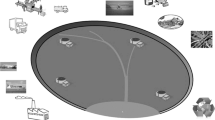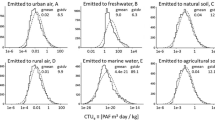Abstract
Toxicity characterization of chemicals’ emissions is a complex task which proceeds via multimedia fate and exposure models attached to models of dose–response relationships. Several different environmental multimedia models exist, but in any case a vast amount of data on the properties of the chemical compounds being assessed is required. This paper deals with the selection of informative variables in the problem of deriving characterization factors for eco-toxicology and human toxicology of chemical compounds starting from molecular-based properties. The Gamma Test algorithm has been applied to single out the most informative variables. The set of variables retained varies with the subset of the original dataset used to carry out the analysis. In particular, 16 different subsets have been used. They have been created selecting each time only those entries in the data set where one chosen input variable was available only from measurements/estimations, respectively.
Access this chapter
Tax calculation will be finalised at checkout
Purchases are for personal use only
Preview
Unable to display preview. Download preview PDF.
Similar content being viewed by others
References
Rosenbaum, R.K., et al.: USEtox®—the UNEP-SETAC toxicity model: recommended characterisation factors for human toxicity and freshwater ecotoxicity in life cycle impact assessment. Int. J. Life Cycle Assess. 13(7), 532–546 (2008)
Birkved, M., Heijungs, R.: Simplified fate modelling in respect to ecotoxicological and human toxicological characterisation of emissions of chemical compounds. Int. J. Life Cycle Assess. 16(8), 739–747 (2011)
Stefánsson, A., Končar, N., Jones, A.J.: A note on the Gamma Test. Neural Comput. Appl. 5, 131–133 (1997)
Huijbregts, M., Hauschild, M., Jolliet, O., Margni, M., McKone, T., Rosenbaum, R.K., et al.: USEtox® User manual (2010)
Jones, A.J.: New tools in non-linear modelling and prediction. Comput. Manag. Science 1(2), 109–149 (2004)
Evans, D., Jones, A.J.: Asymptotic moments of near neighbour distance distributions. Proc. of R. Soc. Ser. A 458(2028), 2839–2849 (2002a)
Evans, D., Jones, A.J.: A proof of the Gamma Test. Proc. of R. Soc. Ser. A 458(2027), 2759 (2002b)
Monte, R.A.: A random walk for dummies. MIT Undergrad. J. Math. 1, 143–148 (1999)
Jones, A.: The winGammaTM User Guide (1998), http://users.cs.cf.ac.uk/O.F.Rana/Antonia.J.Jones/GammaArchive/IndexPage.htm
Durrant, P.: winGammaTM: A non-linear data analysis and modelling tool with applications to flood prediction system. Ph.D. thesis, University of Wales, Cardiff, Wales U.K (2001), http://www.cs.cf.ac.uk/user/Antonia.J.Jones
Author information
Authors and Affiliations
Editor information
Editors and Affiliations
Rights and permissions
Copyright information
© 2014 Springer International Publishing Switzerland
About this paper
Cite this paper
Marvuglia, A., Kanevski, M., Leuenberger, M., Benetto, E. (2014). Variables Selection for Ecotoxicity and Human Toxicity Characterization Using Gamma Test. In: Murgante, B., et al. Computational Science and Its Applications – ICCSA 2014. ICCSA 2014. Lecture Notes in Computer Science, vol 8581. Springer, Cham. https://doi.org/10.1007/978-3-319-09150-1_47
Download citation
DOI: https://doi.org/10.1007/978-3-319-09150-1_47
Publisher Name: Springer, Cham
Print ISBN: 978-3-319-09149-5
Online ISBN: 978-3-319-09150-1
eBook Packages: Computer ScienceComputer Science (R0)




